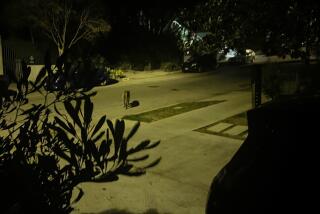‘Paw Project’ Eases Declawed Big Cats’ Pain
- Share via
Envy’s tail is wagging, just like a house cat’s. The cougar is sitting in the back of a van at Animal Specialty Group in Los Angeles, waiting to get darted with anesthesia.
Thanks to an organization called the Paw Project, she is about to undergo surgery to correct problems caused by declawing when she was 5 months old. Almost 6 years old now, she may finally be able to walk comfortably after the operation.
Most big cats raised in captivity are declawed as cubs to prevent them from doing damage when they swipe their paws.
“Domestic cats want to scratch your furniture; wild cats want to scratch you,” said Mollie Hogan, who founded Nature of Wildworks, a sanctuary for big cats and other animals in Topanga Canyon.
Declawing, however, can cripple big cats, especially in old age when arthritis aggravates the pain that can come from years of hobbling around on shortened paw bones, said Jennifer Conrad, an exotic-animal veterinarian who started the Paw Project.
The declawing procedure is actually bone amputation. The first bone at the tip of each toe is removed to stop nail growth. But the procedure isn’t 100% effective, and haphazard nail growth, among other problems, can still happen under the skin, leaving a cat in chronic pain.
The declawed cat also loses dexterity. Tendons are cut loose when the bone is amputated. The soft pads that cats rely on to cushion their landings and bear their weight are no longer held in place and slip down like socks with the elastic gone. So the heavy cats pound directly on bone when they walk.
Although they are much smaller, house cats can suffer from the same aftereffects of declawing.
Conrad and her partner, veterinarian Kirk Wendelburg, director of the Animal Specialty Group in Los Angeles, have restored the paws of 20 big cats, including a 550-pound Siberian tiger, 10 cougars, three leopards, a lioness, a lynx and a jaguar.
“We can’t give them back what nature gave them. But I can make them comfortable and stop their suffering,” Conrad said. Conrad and Wendelburg donate their time for these restorative paw surgeries, but the medicines they use are expensive and the surgery suite and technicians need to be paid for.
Since finding out about Conrad’s work, actor Buddy Hackett has helped to defray some of its costs through his nonprofit Singita Animal Sanctuary.
Hogan raised the money for Envy to have the surgery. “I had no idea how detrimental it was to have these cats declawed; now I’m on the anti-declaw rampage with Jennifer,” she said.
Envy was raised with a wolf at a home in Los Angeles. Although it is illegal to keep big cats in California, they can be bought in many states for about $500, less than what some dogs cost, and smuggled in. “They make terrible pets, even if you get them young,” Conrad said. “They turn into wild animals as they mature, no matter what you do.”
When the California Department of Fish and Game confiscated Envy and her wolf companion, Hogan was contacted and told they were a pair and that she had to take them both. After eight months, the wolf was returned to its original owner. Envy whined for two weeks, Hogan said. The wolf and his owner still bring him to visit Envy once in a while.
At the veterinary hospital, after Envy is anesthetized, she is wheeled into the operating room and her eyes are lubricated. Were she unable to blink during the surgery, she could develop open sores.
Her paws are shaved and one is arranged with a tourniquet to hook above the operating table. This will make the blood flow down, away from the paw, reducing blood loss and keeping the paw and the toe bones visible during the operation. Wendelburg starts, Conrad finishes.
“It probably took 20 minutes and $300 to declaw her and now it’ll take us four hours and $1,500 to try to restore the paws,” Conrad said.
Working on Envy, Conrad sees leftover bone from one toe bent under another. This is what Envy has been walking on for more than five years. The extra bone is removed.
More than halfway through the surgery, with much work left to do on Envy’s second paw, her breathing seems slow. The doctors decide to cut short the procedure and wake her up.
It’s a risky business reviving a large, powerful cat, especially one that will be waking up in pain. Envy’s cage is hurriedly retrieved from the van, the incisions on her paws are glued shut and then a drug is given to revive her. Most of her body is in the carrier when she awakes quickly and places a foot to one side, preventing handlers from putting her all the way inside. It’s a tricky moment, but eventually she goes in. For minutes, the cage shakes ferociously with her anger. Later Conrad says she doesn’t think Envy was in real danger, but either way the surgery is over for now.
The next day, Envy is still smarting from the experience, but Hogan says she still feels positive about it, “I went into it knowing the risks involved and I’m still totally in support of the project. Envy would be uncomfortable, if not crippled otherwise.”
She plans to reschedule completion of work on the second paw when Envy is fully recovered.






